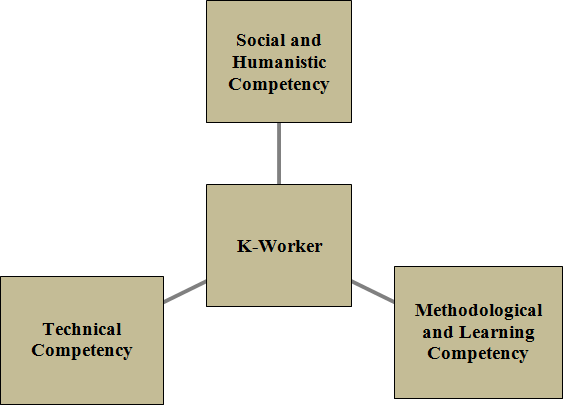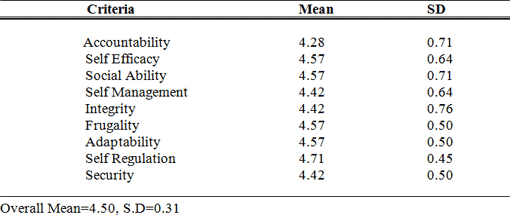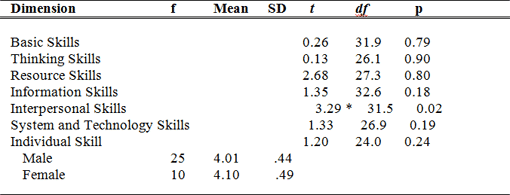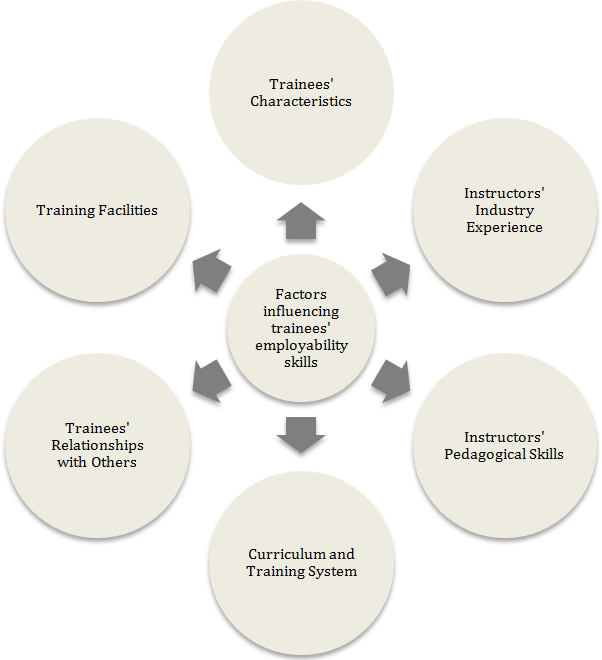Abstract
In the 10th Malaysian Plan 2010-2015, the Government of Malaysia emphasized the mainstreaming of vocational education in its pursuit to transform Malaysia into a high-income developed nation by 2020. To achieve this vision, Malaysia needs more skilled and semi-skilled workers to become knowledge workers (k-workers). The 9th Malaysian Plan indicates that only 28 per cent of the populations in Malaysia are highly skilled workers. To meet the emerging skill requirements for k-workers, vocational education needs to be transformed to equip trainees with requisite skills. Past studies show that in Malaysia there is a gap between the skills learned in training institutions and skills required by employers. However, there are no studies and no model that explores the development process of employability skills in training institutions and the industry. To address this issue, we used a mixed research method (e.g. questionnaire, employability skills survey and grounded theory) to explore the formation of skills in training institutions. The results showed a high level of employability skills among trainees but also the need to consider a number of supporting factors to ensure that skills learned can be applied in the work context.
1 Introduction
Malaysia aspires to reach the status of a developed nation by 2020. To reach that goal, the Government has launched a number of initiatives, e.g. the New Economic Model (NEM), Economic Transformation Programme (ETP), Government Transformation Programme (GTP) and the 10th Malaysia Plan (10MP). As part of the 10th Malaysian Plan, the Government is planning to transform Malaysia into a developed and high-income country over the next five years (Malaysia 2010). Statistics in developed countries such as Singapore, Germany and Australia show that more than 50 percent of their workforce is skilled (Ministry of Human Resources 2011; Government of Malaysia 2009).
An Asia Development Bank (ADB) report cited by Ab. Rahim and Ivan Hanafi (2007), which looked at industrial workers in several countries, including Malaysia, revealed that technical and vocational apprentices did not meet the quality requirements or had adequate motivation levels to work after finishing their training. Faced with stiff global competition, there is rising concern that the current graduates do not match the needs of businesses (Gurvinder & Sharan 2008). Thus, the trust of Malaysian employers in skills of their workers has to be low. The worry is that as a consequence of a lack of confidence in the productivity and expertise of certain industries investors could withdraw their investment. Thus, improving skill levels of apprentices should be a priority in order to enhance investors’ confidence in Malaysia.
1.1 Employability skills: Key ideas
Employability and core ability skills are among popular terms used to refer to the required competencies. These competencies were previously known under a broader concept of generic skills (Bekri et al. 2011) or as generic capabilities, enabling skills or key skills (Berntson, Nääswall & Sverke 2011). The use and popularity of the generic skills concept has increased throughout the world and particularly in Australia since the 1980s. Regardless of the origin of the term used, the objective of discussing these skills is the same, e.g. to find the basis for a set of skills that are important for workers to find and maintain gainful employment. (Cassidy 2006; David & Guile 1998; Mohd Yusof et al. 2010).
The Conference Board of Canada (1996) in an article entitled Yukon Work Futures: Skills for Today’s Workplace has defined employability skills as skills and individual qualities which are required of employees when they start work. In today’s globalized world, many employers require employees who not only have technical or hard skills, but also generic or soft skills (Mohd Yusof 2010). In turn, Overtoom (2000) defined employability skills as “transferable core skills that represent essential functional and enabling knowledge, skills, and attitudes required by the 21st century workplace. They are necessary for career success at all levels of employment and for all levels” (2).
On the one hand, Yahya and Rashid (2004) divide employability skills into three types, namely; academic skills, self- management skills, and group skills. On the other hand, Gainer (1988) groups employability as follows:
- Individual skills (communication skills, respect, computer skills and cultural skills),
- Skills covering individual reliability (individual management, ethical, and vocational maturity)
- Economic skills (problem-solving skills, learning skills, employability and career development skills).
- Group and organizational effectiveness (interpersonal skills, organizational skills, negotiation skills, creativity, and leadership).
It is also acknowledged that generic skills are composed of a unique blend of competencies depending on the occupation and position and can be transferred not only between workplaces but also within and outside the country (Ab Rahim and Ivan 2007; Fitrisehara 2008; Government of Australia 2007; Omar, Bakr & Rashid 2012). For example, teamwork skills used in a fast food restaurant are transferable and applicable to working in a hotel restaurant. Employability is therefore enhanced through adaptability of multi-skills based on employer requirements (Overtoom, 2000; Safarin & Kamarudin 2004; Ab. Rahim & Ivan 2007).. Nilsson (2010) also noted that employability skills include the ability to find a job and maintain employment.
With regard to the environment necessary to develop innovative employees, Kay, Fonda & Haye (1998) identified four key points:
- First, all stakeholders – college staff, managers and students – need to work closely together at the planning and implementation levels.
- Second, knowledge-based curriculum requirements have to be replaced with an integrated learning system, more appropriately geared to the needs of business and incorporating themes such as management, communication or information technology into the integrated learning system.
- Third, teaching and learning should be a reflective process.
- Fourth, vocational qualifications should be acquired as part of this process. They are important but should not be the ultimate goal for trainees.
In general, employability skills are non-technical and are one type of job skills that are as important as technical skills (Rasul et al. 2009). Hence, there is a demand for critical employability skills that can be obtained through vocational training. Kilpatrick and Allen (2001) recognize the increased importance of employability skills and emphasize the need for them to be imparted in vocational training. In that regard, Noraini and Noor (2008) found that 80 per cent of their study respondents felt that in their training they were not only exposed to academic and specialized skills but also employability skills, such as management and teamwork. Often employability skills are considered less important for employment in comparison with specialized skills and personal characteristics. However, this needs to change given employer demand for workers who can cope with a variety of challenges in constantly changing workplaces.
1.2 Employability skills in Malaysia
There seems to be a consensus among Malaysian employers that graduates are well trained in their areas of specialization but lack employability skills (Nurita, Shaharudin & Ainon 2004). While the teaching and learning of ‘hard skills’ is facilitated by a standard syllabus and evaluation system, the development of ‘soft skills’ remains a difficult task as it involves less measurable elements and varies highly with each individual according to their character and background (Roslina Shakir 2009).
Abd Hair et al. (2004) conducted a study among students of the Industrial Training Institutes (ILP) and the Mara Skills Institute focusing on the employee demand from employers and labor supply generated by public training institutions. They found that employers require employees to, not only master technical skills, but also demonstrate employability skills. Employers emphasize computer skills, ability to continue learning and positive personal qualities as important. Furthermore, they need employees to be flexible and stay committed to their companies.
Thus, higher education especially vocational training in Malaysia needs to be developed to include the teaching and learning of employability skills to enable students to transfer skills and knowledge to the changing workplaces after they graduate. In Malaysia, the Quek study (2005) found that graduate workers consider interpersonal abilities, knowledge and skills, such as flexibility, as very important in contributing to their success in the workplace. In addition, they consider practical orientation abilities and cognitive skills as important for their successful job performance. These employability skill are important for Malaysian graduates to enable them to transfer learning from the classroom to the workplace and for successful work performance (Quek, 2005).
1.3 K-Worker Framework in Malaysia
The K-Worker Competency Framwork, which in some respect is similar to the concept of employability skill, encompasses three elements required to produce ’k-workers’. Our research is based on Wan Seman’s (2007) discussion of the National Dual Training System[1] (NDTS) which suggests that training in technical and vocational education should produce k- workers by addressing three competencies: (1) technical competency, (2) social and humanistic competency, and (3) methodological and learning competency (see Figure 1).
Figure 1: K-Worker Competency Framework (Wan Seman, 2007)
These three competencies are crucial for producing highly skilled workers. Technical competency should be the focus for any job. Nevertheless, it must be complemented by social and humanistic competencies, as well as methodological and learning competency. Both competencies are very important, not only during hands-on training, but also for real work in order to support lifelong learning.
2 Problem Statement
Malaysia implements Technical and Vocational Education (TVE) through the a system comprising the Malaysian Skills Certificate (SKM), the National Dual Training System (SLDN) and the National Modular Certificate (SMK) (Ahmad Tajudin Jab 2010). The implementation of this system is based on an apprenticeships that involve on-the-job training and learning in Public Skills Training Institutes (ILKA). The system aims to create highly skilled k-workers who are important for Malaysia in its quest to achieve the status of a high income country. To achieve this goal, it is important to increase the number of trainees in TVE and improve the overall quality of training offered (Mohd. Gazali 2011). However, how to create training that produces highly skilled k- workers through ILPKL remains to be determined. This question is important because previous studies (Ministry of Human Resources 2011; Centre for Instructor and Advanced Skills 2007; Rajiv 2009; UPM 2012) found that there is a gap between the skills required by employers and the skills imparted in training institutes in Malaysia.
3 Research Questions
The research questions are designed to overcome the research problem. The research problem of existing skills gaps can be effectively explored by studying trainees’ inherent skills and the formation process of these skills.
We identified three research questions to be addressed as follows:
RQ1: What is the level of employability skills among trainees in industrial training institutes?
RQ2: Are there any differences in the level of employability skills between genders?
RQ3: What are the factors that contribute to a higher level of employability skills?
4 Methodology
4.1 Mixed-method approach
This study researches modern apprenticeship training in industrial training institutes in Malaysia. It uses grounded theory and analyses data on employability skills such as basic skills, thinking skills, resource skills, information skills, interpersonal skills, system and technology skills and individual characteristics.
4.2 Participants and research instruments
Questionnaires were adopted from Mohammad Sattar et al. (2009) and were used as instruments to measure employability skills. The questionnaire was divided into two section: (a) demography and (b) skills constructs including basic skills construct, thinking skills construct, system and technology skills construct and individual skills construct.
Random sampling method was used for data collection. Samples included trainees from various disciplines and of different genders. A total of 35 respondents, who were undergoing on-the-job training, responded to the questionnaires. 13 out of 35 respondents were further interviewed to explore the factors contributing to higher levels of employability skills. Interviews were also conducted with employers and academic staff.
4.3 Limitations
This study is limited to one industrial training institute, the Industrial Training Institute of Kuala Lumpur (ILP). The institute was chosen as a recognized training institution, e.g. a center of excellence for industrial training in the automotive sector.
4.4 Data analysis
- Quantitative data was analyzed using the software SPSS version 19. Analysis was conducted of frequency, mean, standard deviation, t-test and correlation to answer the aforementioned research questions. Interpretation of results is based on the following information.
|
Level |
Mean Range |
|
Low |
1-1.6 |
|
Moderate |
1.7-3.2 |
|
High |
3.3-5 |
- Qualitative data was analyzed usingthe software NVivo version 8. Open-ended question were followed by verbatim transcription in which open, axial and selective coding was utilized.
5 Study results
5.1 Quantitative research
5.1.1 Gender distribution and demographic information of respondents
Table 1 shows gender distribution and demographic information of respondents involved in the study. Data shows that 71.4 per cent of respondents were male and 28.6 per cent were female. It also indicates that 85.7 per cent of respondents are living in urban while 14.3 per cent of respondents live in rural areas.
Table 1: Gender distribution and location
5.1.2 Mean and standard deviation analysis of employability skills
Table 2 shows that trainees have a high level of basic skills (Mean = 3.82, SD = 0.58). This indicates that training institutes are effectively imparting these skills.
Table 2: Mean and standard deviation (SD) of the basic skills construct
Table 3 shows that trainees possess thinking skills at a high level (Overall Mean = 3.97, SD = 0.52).
Table 3: Mean and standard deviation (SD) of the thinking skills construct
Table 4 shows that trainees possess a higher level of resource skills than basic and thinking skills (Mean = 4:14, SD = 0.53). This result indicates that trainees have well-developed skills to explore available resources.
Table 4: Mean and standard deviation (SD) of the resource skills construct
Table 5 shows the mean and standard deviation for information skills. Results indicate that trainees have a high level of information searching skills (Mean = 3.89, SD = 0.53). These skills are important for trainees to find material and information, and to improve their learning outcomes.
Table 5: Mean and standard deviation (SD) of the information skills construct
Table 6 shows data on interpersonal skills which provides information on how trainees socialize. Results show that trainees have a high level of interpersonal skills (Mean = 4:14, SD = 0.54).
Table 6: Mean and standard Ddviation (SD) of the interpersonal skills construct
Table 7 shows data on system and technology skills. It indicates that trainees have a high level of these skills (Mean = 4:02, SD = 0.55) and are, therefore, able to use systems and technology well. This ability can help trainees to become highly skilled.
Table 7: Mean and standard deviation (SD) of the system and technology skills construct
Table 8 shows the outcome for individual skills which vary according to individual understanding. Trainees seem to possess individual skills at a higher level than other skills (Mean = 4.50, SD = 0.31) which clearly indicates that training institutes have developed a training system that enables trainees to acquire this competence without friends’ help
Table 8: Mean and standard deviation (SD) of the individual skills construct
Table 9 shows the differences between genders in terms of skill constructs that fall under employability skills. The results show that there are no significant differences between the genders in relation to employability skill, except in terms of interpersonal skills. This outcome indicates that men and women think and act differently in regard to interpersonal relations.
Table 9: T-test analysis of differences in employability skills between genders
Table 10 shows the correlation between the skill constructs under the broader term of employability skills. Results indicate that all skill constructs are important for increased level of employability skills.
Table 10: Correlation analysis on the relationship between different constructs of employability skills (f=35)
Results show that the highest mean for individual skills is 4.5 and the lowest 3.82, which is still considerably high. Overall results shows that trainees possess a satisfactory level of employability skills. The relatively high level of skills could be attributed to synergies between training institutions and the industry.
5.2 Qualitative research
The study explores factors that contribute to the development of employability skills among respondents. Findings show that there are six main factors that influence the development of high levels of employability skills (see Figure 2).
Figure 2: Factors influencing the level of trainees’ employability skills
The following are some statements and conclusions drawn from the qualitative discussions:
- Trainees’ characteristics
Trainee characteristics seem to contribute to the formation of high levels of employability skills.
“I’m really interested in my studies. That’s why I managed to be among the outstanding trainees here”.
- Trainees’ relationships with others
Students’ employability skills seem to be enhanced through their relationship with others inside and outside their training institution. Relationships with parents, the community, employers, seniors, and co-workers play an important role. Since Malaysia is a Muslim country, the relationship with God seems to also be quite important.
“Friends and supervisors helped me, as well as the work here. During practical workshops, if there is a problem, I ask my friend. If they do not know, then I consult with my seniors”.
- Instructors’ industry experience
An instructor’s industry experience is an important factor that can support students’ development of technical and employability skills. Trainees appreciated the fact that their supervisors shared their industry experiences with them. They felt that supervisors gave them a true picture of the work environment.
- Instructors’ pedagogical skills
Instructors’ pedagogical skills seem to play a key role in ensuring improved levels of employability skills.
“Supervisors show us how to do things before we do them on our own. Subsequently, we are able to do the job by ourselves, and if there are any mistakes, the lecturer will help”
“I love the way our lecturer teaches. He gives us a reason to practice.”
- Curriculum and training system
A training system is necessary to ensure quality of training and a recognized level of trainee skills. Findings show that the system of curriculum-based training and industry involvement can help trainees to successfully transition from school to work.
“During industrial training, I found that the work environment is similar to the training environment in the Industrial Training Institutes (ILP). This makes it easier for me to adapt to the working environment”.
“I am grateful for the training I get in the Industrial Training Institutes (ILP) as it helped me to become a good employee. Good lecturers and facilities helped me to succeed”.
- Training facilities
Training facilities need to comparable with those used in the industries.
“Training facilities used in our institute are the same as available in the industry. This allows us to practice using the latest technology and gives us the comparative advantage in the workplace”.
“We are given the opportunity to try all the manufacturing tools to gain experience, but due to insufficient time, we were unable to use all of the available machines.”
6 Findings
Employability skills are skills needed by trainees to increase their employability and chances of being promoted based on their satisfactory work performance. Overall, the study results showed that trainees possess a high level of employability skills. Correlation analysis was used to examine the skill constructs which all seem necessary for trainees. The findings meet the purpose of this study which is to find the basis for a set of skills that are important for trainees to become employable k-workers. It should be mentioned that all trainees who filled in the questionnaires, completed their industry training with good results based on employer reports.
This study also showed that the training institute administrators recognize the skills gaps, and should therefore take the initiative to ensure that employability skills are developed in students. This is important because, not only technical skills, but also employability skills are now a priority for industries (Rasul et al. 2009).
In addition, the study showed that there is no significant difference between genders with regards to employability skills, except in relation to interpersonal skills. These findings are inconsistent with the findings of Shakir (2009) who found different skill levels between the sexes. The current study established that the only difference exists in the level of interpersonal skills.
Finally, qualitative data shows that that there are six key factors that influence the development of high levels of employability skills: (1) trainees’ characteristics, (2) trainees’ relationships, (3) instructors’ industry experience, (4) instructors’ pedagogical skills, (5) curriculum and training systems and the (6) training facilities.
7 Conclusion
The issue of skill gaps and mismatches between skills imparted by vocational institutes and skills needed by employers can be addressed if trainers have the requisite skills and operate in adequate environments. The factors making up this holistic approach to developing employability skills include trainees’ characteristics, trainees’ relationships inside and outside the training institute, instructors’ industry experience, instructors’ pedagogical skills, curriculum and training systems, and the quality of training facilities. Divergence between learning outcomes and labour market needs can be addressed if trainees are able to adapt to new working environments and have the ability and motivation to continue learning. Trainees who start with little knowledge can thus become k-workers supporting the development of their country.
To establish a holistic picture of employability skills for k-workers, we will continue the study using grounded theory methods to explore the social processes that form the basis for high levels of employability skills among trainees.
References
Awang, A.H., Hamzah, A., & Rahmah, I. (2004). Kemahiran Bolehkerja: Keseimbangan Antara Tuntutan Majikan dan Penguasaan Pelajar. PersidanganKebangsaan Penyelidikan Siswazah Pengajian Pendidikan .
Bakar, A.R. & Hanafi, I. (2007). Assessing Employability Skills of Technical-Vocational Students in Malaysia. In: Social Sciences, 3(4), 202-207.
Bakar, A.R., Shamsiah Mohamed, & Ramlah, H. (2013). An Assessment of Workplace Skills Acquired by Students of Vocational and Technical Education Institutions. In: International Education Studies, 6(11), 15–20. doi:10.5539/ies.v6n11p15.
Bekri R. et al. (2011).Penguasaan Core Abilities Pekerjaan Dalam Kalangan Graduan Diploma Kemahiran Malaysia Penyejukan Dan Penyaman Udara: Satu Kajian Kes. Prosiding Seminar Serantau Kelima Tahun 2011 Universitas Riau, Pekan baru dan Universiti Kebangsaan Malaysia pada 12 – 14 Mei 2011, Pekan Bau Riau, Indonesia.
Berntson, E., Nääswall, K., & Sverke, M. (2011). Investigating the relationship between employability and self- efficacy : A cross-lagged analysis. In: European Journal of Work and Organizational Psychology, 17(4), 413-425.
Cassidy, S. (2006). Developing employability skills: peer assessment in higher education. In: Education + Training, 48(7), 508-517.
Pusat Latihan Pengajar & Kemahiran Lanjutan (CIAST) (2007). Laporan Kaji Selidik ‘Employability’ Lepasan Graduan ILJTM Majlis Konvokesyen ILJTM tahun 2006.
Fitrisehara, K., Hamzah, R., & Bakar, A. R. (2009). Employability Skills Among the Students of Technical and Vocational Training Centers in Malaysia. In: European Journal of Social Sciences, 9(1), 147-160.
Fuller, A., & Unwin, L. (2003). Learning as Apprentices in the Contemporary UK Workplace: creating and managing expansive and restrictive participation. In: Journal of Education and Work, 16(4), 407-426. doi:10.1080/1363908032000093012.
Gainer (1988). ASTD Update: Basic Skills.
Guile, D. & Young, M. (1998). Apprenticeship as a conceptual basis for a social theory of learning. In: Journal of Vocational Education & Training, 50(2), 37–41.
Gurvinder Kaur Gurcharan Singh & Sharan Kaur Garib Singh. (2008). Malaysian Graduates’ Employability Skills. In: UNITAR E-JOURNAL, 4 (1), January 2008.
Harvey, L. (2001). Defining and Measuring Employability. In: Quality in Higher Education, 7, 2, 97-109.
Hesketh, A. (2000). Recruiting an elite? Employers’ perceptions of graduate employment and training. In: Journal of Education and Work 13 (3), 245-71.
Kay, C., Fonda, N., & Hayes, C. (1998). Growing an innovative workforce: a new approach to education and training. In: Education + Training34(3), 267-275.
KilPatrick, S. & A1len, K. (2001). Review of research: factors influencing demand for vocational education and training courses. Kensington: National center vocational education research.
Lave, J. & Wenger, E. (1991). Situated Learning – Legitimate Peripheral Participation. Cambridge: Cambridge University Press.
Lesgold, A., Feuer, M.J. & Black, A.M. (1997). Transitions in Work and Learning: Implications for Assessment. Washington: National Academy Press.
Maizam, A. & Razali, H. (2013). TVET agency-industry collaborations: addressing diversity. In: The Online Journal for Technical and Vocational Education and Training in Asia, 1(1), 1-15.
Ministry of Human Resources (2011). Kajian Tahap kebolehkerjaan graduan persijilan kemahiran Malaysia di Institut Latihan Kemahiran Awam.
Mohd. Gazali Abas. (2011). Isu-isu semasa Dalam Pendidikan Latihan Teknikal dan Vokasional di Malaysia. JPM. Unit Perancang Ekonomi. Kuala Lumpur.
Mohd Yusof Husain, Seri Bunian Mokhtar, Abdul Aziz Ahmad, & Ramlee Mustapha (2010). Importance of Employability Skills from Employers’ Perspective. In: Procedia – Social and Behavioral Sciences, 7(C), 430–438. doi:10.1016/j.sbspro.2010.10.059.
Nilsson, S. (2010). Enhancing individual employability: the perspective of engineering graduates. In: Education + Training, 52(6/7), 540–551. doi:10.1108/00400911011068487.
Noraini Mohd Noor & Noor Murni Abd Sukor (2008). Penerapan Kemahiran Employability di Institut Latihan Perindustrian Pasir Gudang Johor.
Nurita, Shaharudin & Ainon (2004). A survey of students’ employability skills: A case of Unitar.
Omar, M.K., Bakar, A.R. & Rashid, A.M. (2012). Employability skill acquisition among Malaysian community college students. In: J. Soc. Sci., 8, 472-478.
Overtoom, C. (2000). “Employability skills: An update.” ERIC Digest No. 220.
Quek Ai-Hwa (2005). Learning for the workplace: a case study in graduate employees’ generic competencies. In: Journal of Workplace Learning, 17, 4,231-242.
Rajiv Rasikchandra Malkan (2009). Post-Secondary Technical Vocational Education Training: A Qualitative Case Study of Industrial Training Institute (ITI) In Maharasthra State, India. PhD Dissertation of the Graduate College at the University of Nebraska.
Rasul, M.S. et al. (2009). Aspek Kemahiran “Employability” yang Dikehendaki Majikan Industri Pembuatan Masa Kini (Aspects of Employability Skills Needed by the Manufacturing Industries Employers). In: Jurnal Pendidikan Malaysia, 34(2), 67–79.
Shakir, R. (2009). Soft skills at the Malaysian institutes of higher learning. In: Asia Pacific Educ. Rev, 10, 309-315.
Safarin & Kamarudin (2004). Kemahiran Generik – Kepentingannya Dalam Memenuhi Kepeluan Majikan Masa Kini. Prosiding National Conference on Graduate Research in Education.
The Conference Board of Canada (1996). Employability Skills. Ottawa Ontario.
Universiti Putra Malaysia (UPM) (2012). Kajian Tahap Penerimaan Masyarakat Terhadap Latihan Kemahiran. Report.
Yahya Buntat & Muhammad Rashid Rajuddin (2004). “Aspek-Aspek Penting dalam kemahiran Employability.” In: Buletin Fakulti Pendidikan Universiti Teknologi Malaysia, no. 2, 3.
[1]On 19 May 2004, the government of Malaysia decided to implement the National Dual Training System (NDTS). It created an agency under the Ministry of Human Resources, the Department of Skills Development (DSD), previously known as the National Vocational Training Council (NVTC), responsible for the introduction and implementation of the NDTS system. This initiative is expected to stimulate the production of k-workers to meet the rapid development of the nation towards vision 2020. NDTS was introduced to produce k-workers under a comprehensive and updated training system and to meet the needs of the industries (Wan Seman, 2007)
Citation
Che Rus R., Yasin R. M., & Rasul, M. R. (2014). From zero to hero: Becoming an employable knowledge worker (k-worker) in Malaysia. In: TVET@Asia, issue 3, 1-16. Online: https://www.tvet-online.asia/issue3/che-rus_etal_tvet3.pdf (retrieved 30.06.2014).
















